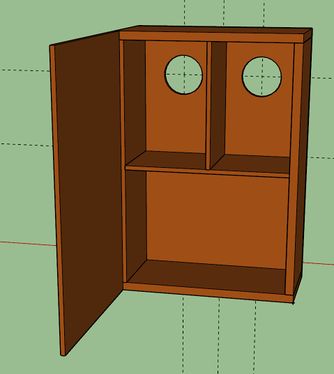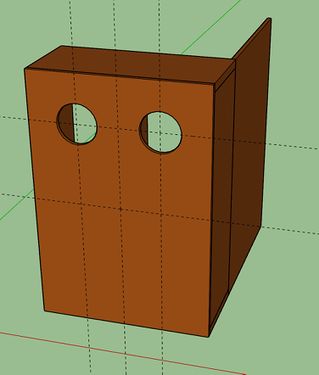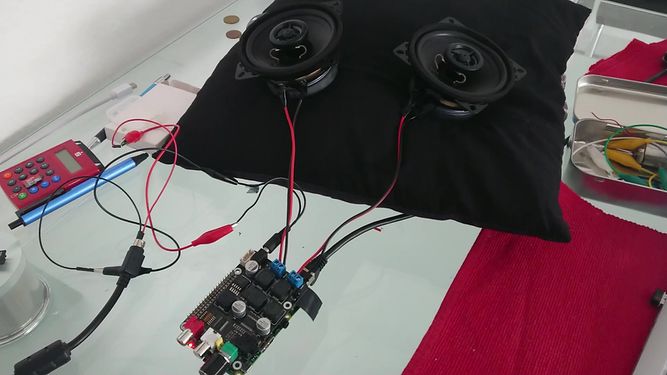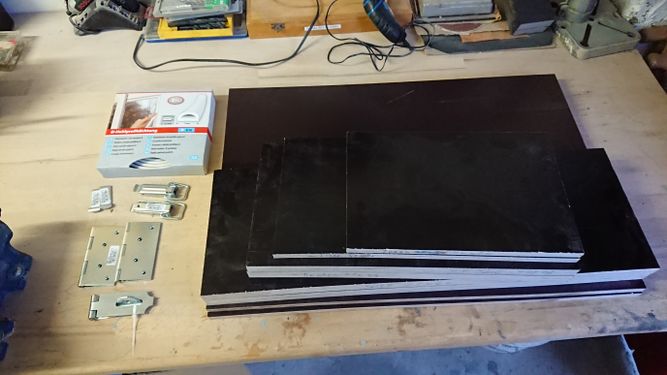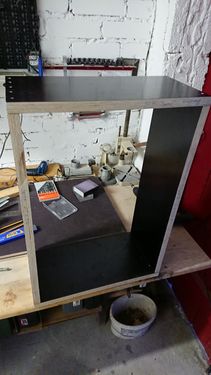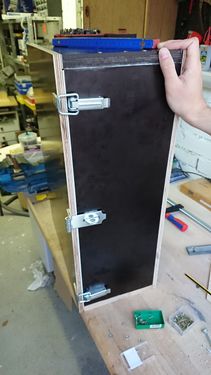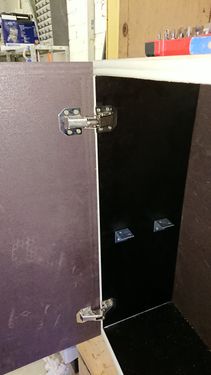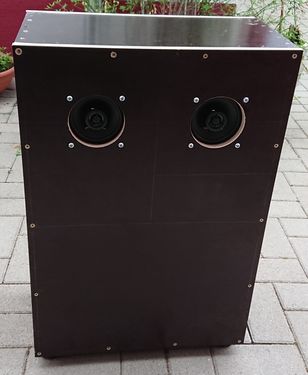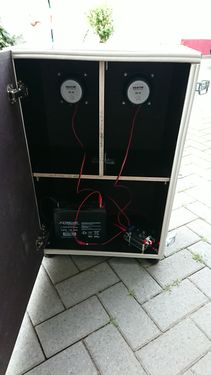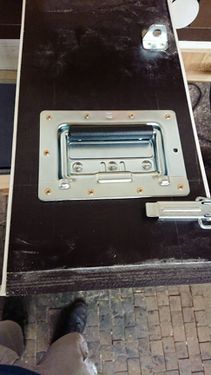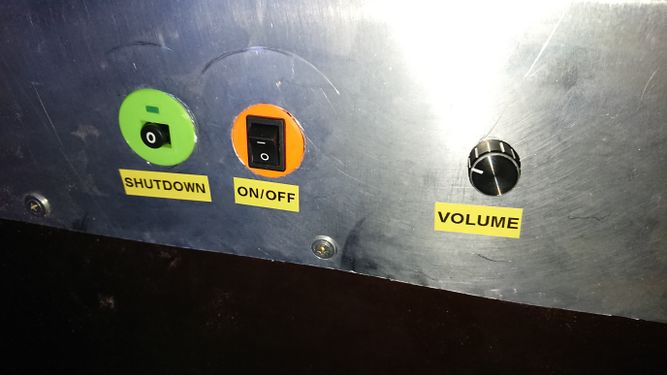Project:Music Station: Difference between revisions
m →Hardware: some additional links |
→Different speaker: Link fixed |
||
| (10 intermediate revisions by 2 users not shown) | |||
| Line 1: | Line 1: | ||
{{ProjectInfoBox | {{ProjectInfoBox | ||
|project title=Music Station | |project title=Music Station | ||
|image=MusicStation. | |image=MusicStation 06.jpg | ||
|status= | |status=done | ||
|date= | |date=August 2018 | ||
|initiator= | |initiator={{NL}} | ||
|team= | |team={{NL}} | ||
|tools=[[Raspberry Pi]] | |tools=[[Raspberry Pi]] | ||
|software=[https://github.com/ | |materials=[[Film Faced Plywood|film faced plywood]] | ||
|software=[https://github.com/NitramLegov/Musicbox Musicbox] | |||
}} | }} | ||
Since existing bluetooth speakers do not provide enough power, {{NL}} decided to build custom speakers for usage on the camping ground of different festivals. | |||
== Software == | == Software == | ||
The | The system is based on a regular Rasbian Lite installation, which gets adjusted by the installation script in the following way: | ||
# Installation and configuration of mopidy and useful extensions | |||
# Installation and configuration of bt_speaker | |||
== Hardware == | == Hardware == | ||
From an electronics perspective, the system uses a [[Raspberry Pi]] in combination with a [http://www.suptronics.com/xseries/x400.html X400 HAT]. | |||
It gets powered by a couple of lead batteries. | |||
The wiring is as follows: | |||
GPIO 22 & GND are connected to the shutdown button. | |||
GPIO 14 & GND are connected to the status LED. | |||
== Further Improvements | |||
The case is built with [[Film Faced Plywood|film faced plywood]]: | |||
<br clear="all"/> | |||
<gallery mode=packed-hover heights=250> | |||
File:MusicStation_09.jpg|First draft in [[SketchUp]] | |||
File:MusicStation_10.jpg|First draft in [[SketchUp]] | |||
File:MusicStation_01.jpg|The electronics arrived and had to be tested | |||
File:MusicStation_02.jpg|Materials for building the box | |||
File:MusicStation_03.jpg|First part done | |||
File:MusicStation_04.jpg|The door got attached | |||
File:MusicStation_05.jpg|Inside of the door | |||
File:MusicStation_06.jpg|Box built | |||
File:MusicStation_07.jpg|First test of the assembled box | |||
File:MusicStation_11.jpg|Added some handles | |||
File:MusicStation_08.jpg|And finally control buttons | |||
</gallery> | |||
== Further Improvements == | |||
===Check possibility to use a ESP32=== | |||
On the last Festival, I was mainly using the bluetooth functionality. Playback using Mopidy as well as the Wifi Hotspot was not really used. For bluetooth playback, a ESP32 should be enough. This should lower the needed power significantly. | |||
===Shutdown board in case of power losses=== | |||
Since the system is powered by batteries, there is a possibility of sudden power outages due to a lack of remaining battery power. Therefore, there should be a circuit which either switches from one battery to another and then possibly sends a shutdown signal to the system. | |||
Note: This is only needed for Raspberry Pi based systems. | |||
===Different speaker=== | |||
So far the system is based on [https://www.visaton.de/en/products/drivers/coaxial-speakers/px-10-4-ohm Visaton PX-10 speakers]. Since they don't provide ''[https://de.wikipedia.org/wiki/Thiele-Small-Parameter Thiele/Small parameters]'', I didn´t calculate the needed box volume and just made a 12 liter box for each speaker, which is most likely way too much. | |||
The next version should use different speakers where the ideal box volume is known. | |||
===Make a workshop out of it=== | |||
Once the new design is complete and tested, there could be a [[seminar]] in which we teach others to build their own bluetooth speaker. | |||
===Design a 3D-Printed front for the controls=== | |||
[[Category:Audio]] | [[Category:Audio]] | ||
[[Category:Electronics]] | |||
[[Category:Raspberry Pi]] | [[Category:Raspberry Pi]] | ||
[[Category:Woodworking]] | |||
Latest revision as of 17:14, 3 March 2021
| ProjectInfoBox Music Station | |
|---|---|
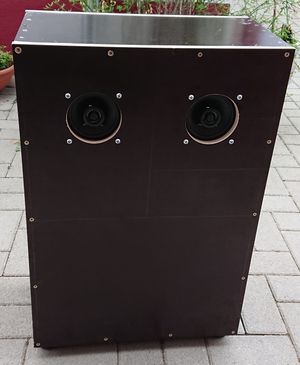
| |
| Status: | done |
| Release Date: | August 2018 |
| Initiator: | Martin |
| Team: | Martin |
| Materials Used: | film faced plywood |
| Tools Used: | Raspberry Pi |
| Software Used: | Musicbox |
Since existing bluetooth speakers do not provide enough power, Martin decided to build custom speakers for usage on the camping ground of different festivals.
Software
The system is based on a regular Rasbian Lite installation, which gets adjusted by the installation script in the following way:
- Installation and configuration of mopidy and useful extensions
- Installation and configuration of bt_speaker
Hardware
From an electronics perspective, the system uses a Raspberry Pi in combination with a X400 HAT. It gets powered by a couple of lead batteries.
The wiring is as follows: GPIO 22 & GND are connected to the shutdown button. GPIO 14 & GND are connected to the status LED.
The case is built with film faced plywood:
-
First draft in SketchUp
-
First draft in SketchUp
-
The electronics arrived and had to be tested
-
Materials for building the box
-
First part done
-
The door got attached
-
Inside of the door
-
Box built
-
First test of the assembled box
-
Added some handles
-
And finally control buttons
Further Improvements
Check possibility to use a ESP32
On the last Festival, I was mainly using the bluetooth functionality. Playback using Mopidy as well as the Wifi Hotspot was not really used. For bluetooth playback, a ESP32 should be enough. This should lower the needed power significantly.
Shutdown board in case of power losses
Since the system is powered by batteries, there is a possibility of sudden power outages due to a lack of remaining battery power. Therefore, there should be a circuit which either switches from one battery to another and then possibly sends a shutdown signal to the system.
Note: This is only needed for Raspberry Pi based systems.
Different speaker
So far the system is based on Visaton PX-10 speakers. Since they don't provide Thiele/Small parameters, I didn´t calculate the needed box volume and just made a 12 liter box for each speaker, which is most likely way too much.
The next version should use different speakers where the ideal box volume is known.
Make a workshop out of it
Once the new design is complete and tested, there could be a seminar in which we teach others to build their own bluetooth speaker.
